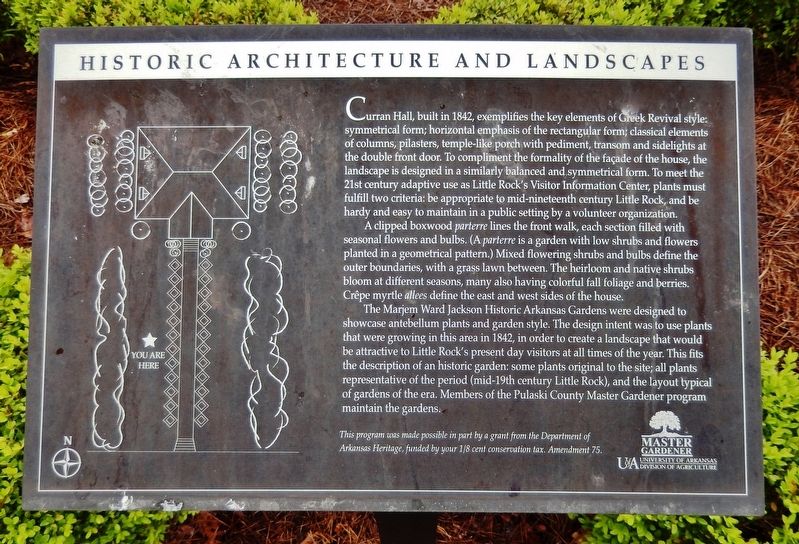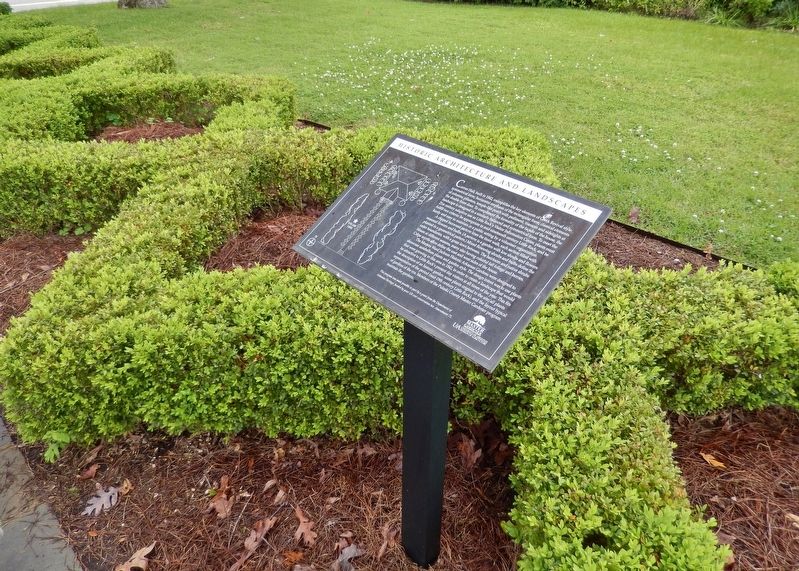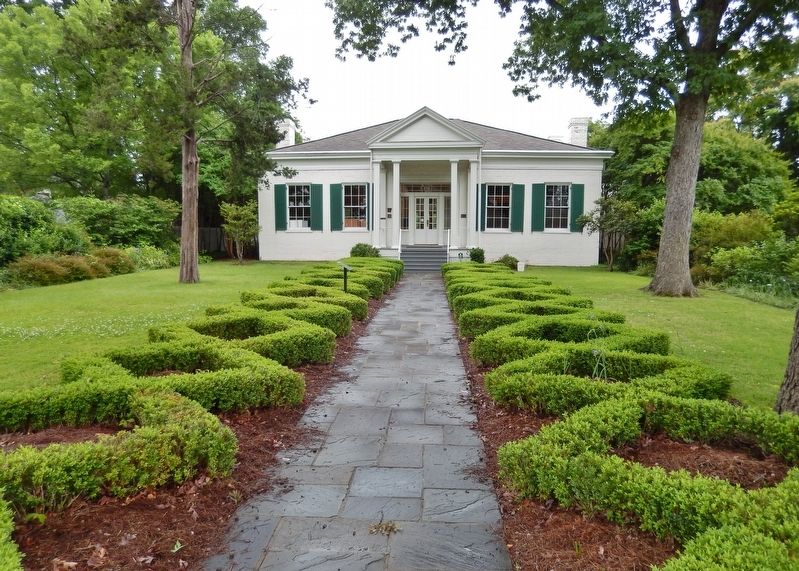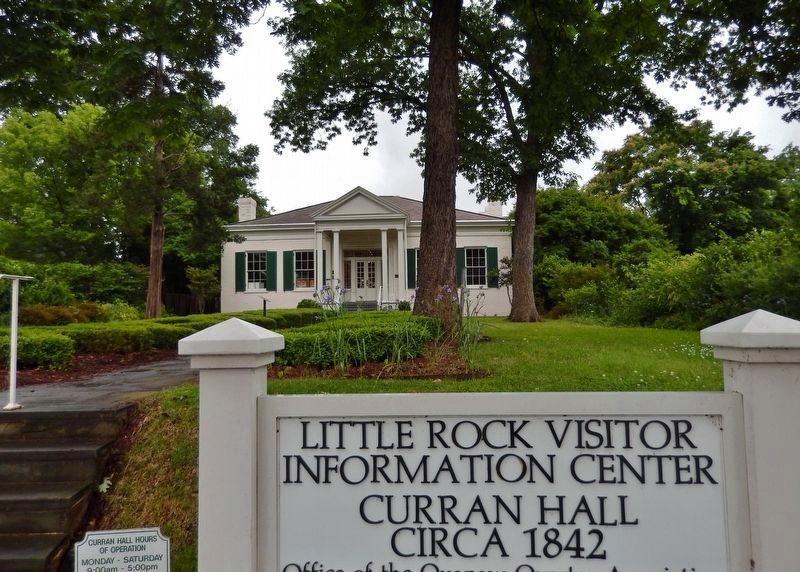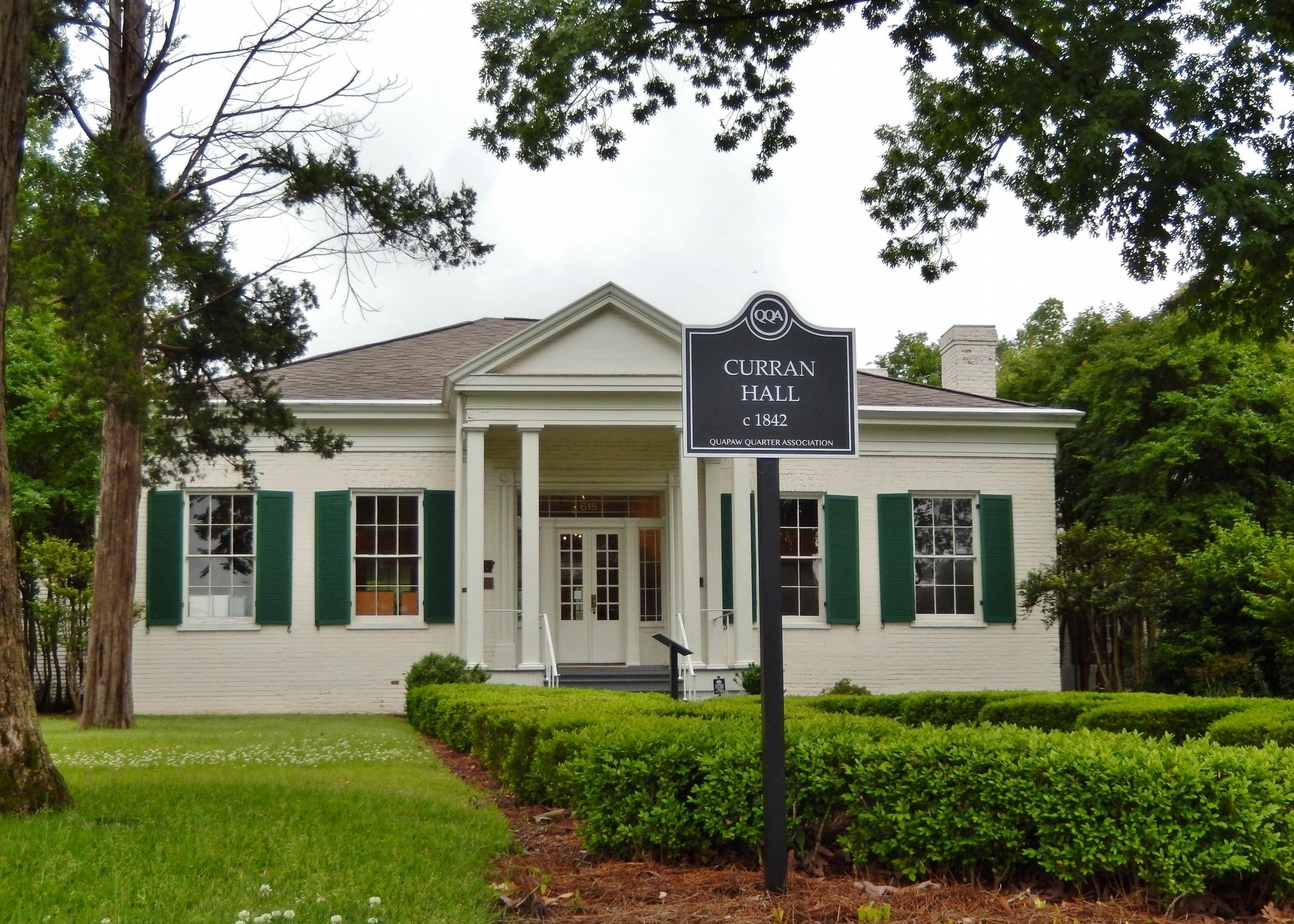Macarthur Park in Little Rock in Pulaski County, Arkansas — The American South (West South Central)
Curran Hall
Historic Architecture and Landscapes
Curran Hall, built in 1842, exemplifies the key elements of Greek Revival style: symmetrical form; horizontal emphasis of the rectangular form; classical elements of columns, pilasters, temple-like porch with pediment, transom and sidelights at the double front door. To compliment the formality of the façade of the house, the landscape is designed in a similarly balanced and symmetrical form. To meet the 21st century adaptive use as Little Rock's Visitor Information Center, plants must fulfill two criteria: be appropriate to mid-nineteenth century Little Rock, and be hardy and easy to maintain in a public setting by a volunteer organization.
A clipped boxwood parterre lines the front walk, each section filled with seasonal flowers and bulbs. (A parterre is a garden with low shrubs and flowers planted in a geometrical pattern.) Mixed flowering shrubs and bulbs define the outer boundaries, with a grass lawn between. The heirloom and native shrubs bloom at different seasons, many also having colorful fall foliage and berries. Crêpe myrtle allees define the east and west sides of the house.
The Marjem Ward Jackson Historic Arkansas Gardens were designed to showcase antebellum plants and garden style. The design intent was to use plants that were growing in this area in 1842, in order to create a landscape that would be attractive to Little Rock's present day visitors at all times of the year. This fits the description of an historic garden: some plants original to the site; all plants representative of the period (mid-19th century Little Rock), and the layout typical of gardens of the era. Members of the Pulaski County Master Gardener program maintain the gardens.
This program was made possible in part by a grant from the Department of Arkansas Heritage, funded by your 1/8 cent conservation tax. Amendment 75.
Erected by University of Arkansas Division of Agriculture, and Department of Arkansas Heritage.
Topics. This historical marker is listed in these topic lists: Architecture • Charity & Public Work. A significant historical year for this entry is 1842.
Location. 34° 44.583′ N, 92° 15.872′ W. Marker is in Little Rock, Arkansas, in Pulaski County. It is in Macarthur Park. Marker can be reached from East Capitol Avenue just east of Sherman Street, on the right when traveling east. Marker is located along the entrance walkway, directly in front of Curran Hall. Touch for map. Marker is at or near this postal address: 615 East Capitol Avenue, Little Rock AR 72202, United States of America. Touch for directions.
Other nearby markers. At least 8 other markers are within walking distance of this marker. Trapnall Hall (about 600 feet away, measured in a direct line); Johnson House (about 800 feet away); Nash House (approx. 0.2 miles away); a different marker also named Nash House (approx. 0.2 miles away); Tuf-Nut Lofts (approx. 0.2 miles away); St. Edwards Church (approx. ¼ mile away); Augustus Hill Garland (approx. 0.3 miles away); Porbeck & Bowman Building (approx. 0.3 miles away). Touch for a list and map of all markers in Little Rock.
Regarding Curran Hall. National Register of Historic Places #76000453. Also a contributing property in the MacArthur Park Historic District, NRHP #77000269.
Also see . . .
1. Historic Curran Hall. Arkansas website entry:
Conveniently located in downtown Little Rock, Historic Curran Hall, built in 1842, is the city’s only antebellum home open daily to the public. It houses the official Little Rock Visitor Information Center and is the Mayor’s Reception Hall. (Submitted on November 29, 2020, by Cosmos Mariner of Cape Canaveral, Florida.)
2. Curran Hall. Wikipedia entry:
The house is significant as one of the few remaining antebellum era landmarks in Little Rock. It served as the home of pre-Civil war Arkansas Supreme Court Justice George Watkins. Jacob Frolich purchased the home after the war, who would become a post-reconstruction Arkansas Secretary of State. Before that, however, Frolich, an opponent of the reconstruction Arkansas government and fearful of reprisals, fortified Curran Hall with trap doors and placed his livestock inside the house at night. (Submitted on November 29, 2020, by Cosmos Mariner of Cape Canaveral, Florida.)
Credits. This page was last revised on April 21, 2023. It was originally submitted on November 26, 2020, by Cosmos Mariner of Cape Canaveral, Florida. This page has been viewed 143 times since then and 9 times this year. Photos: 1, 2, 3, 4, 5. submitted on November 29, 2020, by Cosmos Mariner of Cape Canaveral, Florida.
